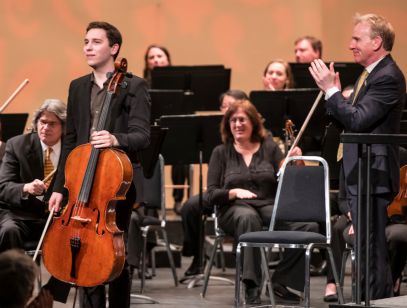|
Symphony
FROM THE NEW WORLD TO THE OLD WORLD
by Peter Lert
Saturday, June 14, 2025
Chamber
MC2 DUO RECITAL CLOSES 222'S SEASON
by Terry McNeill
Saturday, June 14, 2025
Choral and Vocal
CANTIAMO SONOMA'S LUSCIOUS A CAPELLA SINGING IN SEASON ENDING CONCERT
by Pamela Hicks Gailey
Sunday, June 8, 2025
Symphony
SRS SEASON ENDS WITH RESOUNDING TA-TA-TA-BANG
by Terry McNeill
Sunday, June 1, 2025
Symphony
YOUTHFUL VIRTUOSITY ON DISPLAY AT USO'S MAY CONCERTS
by Peter Lert
Saturday, May 17, 2025
Symphony
MYSTICAL PLANETS AND LIVELY GERSHWIN ORTIZ AT FINAL SRS CONCERT
by Peter Lert
Sunday, May 4, 2025
Symphony
VSO'S CONCERT MUSIC OF TIME, MUSIC OF PLACE
by Peter Lert
Sunday, April 27, 2025
VOCAL ELEGANCE AND FIRE AT THE 222'S RECITAL APRIL 26
by Pamela Hicks Gailey
Saturday, April 26, 2025
CANTIAMO SONOMA SINGS AN INSPIRED GOOD FRIDAY MOZART REQUIEM CONCERT
by Pamela Hicks Gailey
Friday, April 18, 2025
DRAMATIC SHOSTAKOVICH SYMPHONY CLOSES PHILHARMONIC'S 25TH SEASON
by Terry McNeill
Sunday, April 13, 2025
|
 |
 Alasdair Neale Leads Applause for Oliver Herbert April 28 |
MARIN SYMPHONY SEASON CLOSES WITH AUTUMNAL ELGAR AND THEATRICAL BEETHOVEN
by Abby Wasserman
Sunday, April 28, 2019
Mozart’s enchanting Overture to his opera The Magic Flute, a miniature tapestry of gems from the 1791 work, opened the Marin Symphony’s final concert of the 2018-2019 season. Under conductor Alasdair Neale, the playing of the sprightly seven-minute piece by a reduced-size classical ensemble sparkled like crystal.
It was Mozart’s practice to compose an overture after completing the respective opera score, so the piece contains intimations of all that is to come: evocation of earth and sky, a villainess and her minions, a master of mysteries, a pure-hearted hero and innocent heroine, lechery, danger, absurdity, love—all swirled into a joyful concoction. The performance was greeted by a capacity audience at the Marin Civic Auditorium with great enthusiasm.
Big, noble works with full orchestra filled the rest of the program: Elgar’s Cello Concerto in E Minor, Op. 85, with soloist Oliver Herbert, and Beethoven’s E-Flat Major Symphony, Op. 55 (Eroica). Mr. Neale has known Mr. Herbert since the latter was a toddler, and their comfortable rapport showed in a splendid reading of the Elgar. This weekend the cellist performed it for the first time in public, and it’s a work that demands technical excellence, tonal power, and lots of soul. Written as World War I was drawing to a close, it mirrors the anxious tenor of the times. Although Elgar lived another 14 years after its premiere, it was to be his last major composition.
Slow in gaining popularity, the concerto, which Elgar termed “a man’s attitude toward life,” is performed more today than most other Elgar compositions. For one critic it signified a “lament for a lost world,” and from the first deep expressions of sorrow, double-stop chords in E Minor, its sense of tragedy is always close by. Near the beginning of the first movement, the cello writing poses a rising series of quasi questions and sighs, which are answered by the violas and then the clarinets and bassoons. A melody of memorable sweetness and a pastoral, undulating passage raise the mood. Throughout the four movements of this epic work, the cello line questions, cherishes, anguishes, and seems to come to terms with the meaning of “a man’s life” in all its complexity. The orchestra playing was stellar, and Mr. Herbert communicated the concerto’s mixed emotions with great skill, heart and strength.
“Masterworks 4: Fearless,” the title for this concert, aptly describes Beethoven’s innovative Third Symphony, written in 1805. This was perhaps his greatest symphonic piece up to the time of its first performance, and wielded substantial influence not only on contemporary composers, but also in the short term influenced his six additional symphonies to come. Its motives and thematic development set a new direction for him; hints of this appear like golden threads in the fabrics of the 5th, 6th, and 7th Symphonies in particular. Although (or because of) suffering at the time from a rapidly accelerating hearing loss, he was able to forge a new, fearless path, breaking away from the Classical form and never looking back.
Forty-seven minutes in most performances, the Eroica presents something of a marathon for any orchestra, but the Marin forces played it beautifully. The first movement (allegro con brio) flings open the doors with two emphatic chords that lead quickly into a strange transition in the cellos to C Sharp. The instruments weigh in individually and in unison to sound a thrilling pulse, emanating great energy, a gathering of forces that never lets up. The second movement, Marche funebre (adagio assai) was a shock to listeners at the time, as there hadn’t been a funeral march before in a symphony. A fugue, led by the strings, was played powerfully through all the instrumental sections and resolved like a chorale before re-introducing the funeral processional. A staccato puttering Scherzo (Allegro Vivace) gave way three times to a mellow horn quartet, led by principal Darby Hinshaw, that might have been a call to the hunt. The movement hurried on energetically once more and ended much as it had begun.
The Eroica’s final movement reasserts the emphatic chords of the first movement, and quickly leads to a rondo, with restatements of motives and themes and a graceful rising to a coda that is its triumphal climax.
As the audience stood to applaud the sterling performance, Mr. Neale singled out in succession the strings, oboes, flutes, clarinets, bassoons, trumpets, horns, and timpanist Tyler Mack for special recognition.
|

